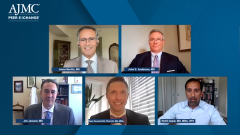
Transformative Opportunities in Population Health for Patients With HF
Drs Uppal and Januzzi explore benefits of population health programs for treating chronic conditions associated with heart failure.
Episodes in this series

Ryan Haumschild, PharmD, MS, MBA: I’d like to transition to talk a little about population health, because population health is continuing to grow in scope and feasibility, but also involvement from many different health care providers. Dr Uppal, as we think about population health from your standpoint, there are a number of programs and strategies designed for patients with heart failure. I’m curious about your thoughts. How do we control the overall cost but support these patients with their chronic conditions to slow the disease progression? Can you talk to us a little about an overview of population health efforts you’re familiar with and some of the goals of these programs?
Rohit Uppal, MD, MBA, SFH: Sure. I may be biased as a hospitalist, but some of the biggest opportunities to address costs are in the acute and post-acute settings. Those are also great opportunities to address quality-of-life outcomes for patients. Our role as a hospitalist is to make sure that we’re matching the intensity of services to the medical needs of the patient. As an example, I’m fortunate to work in an organization that spans the continuum of care. We have emergency medicine, hospital medicine, post-acute care, and even telemedicine, or virtual care. The integration of multiple service lines can have a tremendous impact. One of the keys to population health efforts around CHF [congestive heart failure] is to make sure we’re leveraging all of these clinical touch points to promote and ensure goal-directed therapy.
The rise of telemedicine may be the biggest silver lining of the pandemic. For example, we’re using ED [emergency department] follow-up telemedicine visits to allow ED physicians to safely transition patients home and potentially avoid unnecessary admissions. Our hospital medicine teams are using remote patient monitoring, which is a new tool. In some locations, we’re using the hospital-at-home model, which has the potential to deliver equivalent outcomes at lower costs compared with hospitalizing someone in a facility.
When I think of our role as a hospitalist, I want to emphasize the importance of a team-based approach. Managing CHF is so complex and requires such a comprehensive approach. The key components are typically beyond the expertise of any one person on the team. It’s certainly beyond the skills or knowledge of a hospitalist to be able to meet those needs. The ability to address all of those complex medical and social issues in this population is key.
Our leaders and clinicians are committed to high levels of interdisciplinary teamwork. The interdisciplinary team within the hospital includes nurses, care coordinators, case managers, pharmacists, physical therapists, nutritionists, and others. The effective leadership of that team is an essential role that we play in making sure that we have the appropriate coordination of care for our patients, that we’re providing the right level of patient education, addressing social determinants of health, and then making sure we create safe transitions of care between settings, which we know is a very vulnerable period for our patients.
Ryan Haumschild, PharmD, MS, MBA: You hit on some great points, especially team-based care, social determinants of health, how important they are and previously underutilized. To see them be such a priority for population health strategies is great. Dr Januzzi, you’re doing a lot with our population of patients with heart failure. Is there anything additional that you’re working on or have thoughts around population health programs and the support of these patients?
Jim Januzzi, MD: Thanks very much. This has been such a great discussion because it reveals how we’re all pulling the rope in the same direction, but it takes a lot of hands on the rope to get there. What Dr Uppal said is critically important, that the hospital-based care of the patient with heart failure is probably the single best opportunity for excellent and rapid application of guideline-directed medical therapy [GDMT]. At this pivotal moment, hospitalization represents a circumstance when a person’s prognosis—regardless of ejection fraction—immediately worsens. Now you have this situation where the risk is ramped up, whether you’re a payer, a clinician, or a patient, and you have to think very carefully about how you’re going to address that. It requires this assiduous team-based approach to start guideline-directed medical therapy before discharge.
There was a recent study that showed that the single best predictor of no guideline-directed medical therapy in follow-up was no guideline-directed medical therapy at discharge. What you go home on is what you stay on. But that’s when the ball gets handed off for follow-up. Every institution has a different approach for this. Some places see patients within a week after discharge from a heart failure hospitalization for further adjustment of medication. Other institutions, like the Massachusetts General Hospital, has a GDMT clinic, a guideline-directed medical therapy clinic, where we staff the clinic with individuals who are experts in the application of GDMT, and we understand the little tricks for how to get patients up to higher doses. We’ll talk about that in a bit. This is so that we can essentially catch the ball from the hospitalist who passed it to us, optimize the patient, and then release them back to their regular cardiologist or primary care physician so that we can achieve the goal of getting the optimized medical care that these patients deserve.
Transcript edited for clarity.
Newsletter
Stay ahead of policy, cost, and value—subscribe to AJMC for expert insights at the intersection of clinical care and health economics.





























































